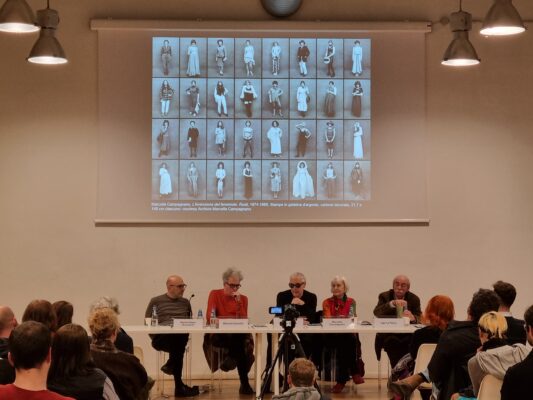Search
To search for an exact match, type the word or phrase you want in quotation marks.
A*DESK has been offering since 2002 contents about criticism and contemporary art. A*DESK has become consolidated thanks to all those who have believed in the project, all those who have followed us, debating, participating and collaborating. Many people have collaborated with A*DESK, and continue to do so. Their efforts, knowledge and belief in the project are what make it grow internationally. At A*DESK we have also generated work for over one hundred professionals in culture, from small collaborations with reviews and classes, to more prolonged and intense collaborations.
At A*DESK we believe in the need for free and universal access to culture and knowledge. We want to carry on being independent, remaining open to more ideas and opinions. If you believe in A*DESK, we need your backing to be able to continue. You can now participate in the project by supporting it. You can choose how much you want to contribute to the project.
You can decide how much you want to bring to the project.

Lecture for Marco Scotini’s book presentation L’inarchiviabile. L’archivio contro la storia (Meltemi Editore, Collana GeoArchivi, Milan, 2023), together with Marcella Campagnano and Ugo La Pietra, at FM Centro per l’Arte Contemporanea, Milan, April 20, 2023.
Good afternoon everyone. First of all, I would like to thank Marco for the double privilege of making me part of this session. It is a privilege to accompany him in the first public presentation of his amazing book L’inarchiviabile, and also to do it together with none other than Marcella Campagnano and Ugo La Pietra, whose work is already a truly important historical reference for all of us.
I would like to start my reading of L’inarchiviabile by taking a step back. Artecrazia. Macchine espositive e governo dei pubblici (DeriveApprodi, 2021), published by Marco two years ago, problematized the way in which neoliberal hegemony expressed itself for several decades as a machine to produce apparently democratic pseudo-public spheres. But Artecrazia also revealed the other face, the construction of alternative non-neoliberal public spheres through the practices that emerged in the conjunction of art, politics and activism between the 1990s-2010s. From there, it seems to me that L’inarchiviabile confronts how the authoritarian evolution of neoliberalism in crisis destroys even that democratic appearance, normalizing the history of authoritarianism and the authoritarianism of history, in such a way that, for example, on the one hand, the naturalization of fascist violence and, on the other hand, the difficulty to assume today the importance of the radical revolts that were carried out after 1968 are two sides of the same problem in Italy and in Europe as a whole.
This is a two-face problem that the practice of the unarchivable, as conceptualized in this book, aims to reverse. In order to de-naturalize both the authoritarianism of history and the naturalization of fascist historical violence it is necessary to reactivate, actualize (in a deleuzian sense) and make present once again the emancipatory radicalizations of the 1960s and 70s.
L’inarchiviabile represents an extraordinarily complex and powerful culmination of a phenomenon that began to manifest itself in the mid-90s, that is, the simultaneously documentary and archival turn of contemporary art, a shift that received a major boost with documenta X in 1997, curated by Catherine David. The first book mentioned by Marco in L’inarchiviabile is Archive Fever, by Jacques Derrida, published in 1996. Derrida had also published, in 1993, Specters of Marx, which is a response to The End of History, published in 1992, by the neoliberal political scientist Francis Fukuyama. In 1998, Jean-Luc Godard (speaking of archives and the unarchiveable) finished his Histore(s) du cinéma. The Zapatista uprising took place in Mexico in 1994, blowing up both the historical teleology of modernity and the neoliberal claim that history would be suspended once the idea of class struggle had been defeated with the fall of the Berlin Wall in 1989.
The sophistication of Marco’s book when it comes to weaving together the interconnections between the documentary turn and the archival turn of contemporary art helps us understand in retrospect the depth and height of the challenges that were being put into play at that essential moment in the mid-1990s regarding the nature of history and the emancipatory importance of reactivating and reconstructing the historical discourse after the 20th century.
In the 1990s, the articulation between the documentary turn and the archival turn began to take shape in the global art system, in a climate in which the resistance against neoliberalism gained philosophical and global projection. At the same time, an articulation between the archival turn and what we could call a “peripheral turn” also begins. This peripheral turn shows two opposite aspects that are also the heads and tails of the same phenomenon:
The effect that the global art market has had on these archives since the 1990s is twofold. On the one hand, it disintegrates and disperses them, separating their components, transforming into marketable art objects what were originally materials that formed an organic and inseparable part of anti-capitalist, anti-patriarchal, and anti-colonial practices. On the other hand, entire archives are reified, becoming volumes of institutionalized materials that, fortunately, finally acquire visibility but that are frozen in time, in such a way that their emancipatory potential for the present is neutralized. If we think about it, the critical and curatorial archival practices that Marco has developed since 2004, and of which this book discusses, are precisely a counter-model of the double tendency to disintegrate and reify the archives of radical practices of the 1960s and 70s that for years have remained invisible to the public. We should remember his curatorship of the 2016 exhibition that gave rise to this book, and that took place in this same FM art center, L’inarchiviabile. Italia anni ‘70, but also in his sucessive exhibitions of Disobedience, a growing, mobile and transnational on-going video-film archive, from its first version in Berlin in 2004 to the last one at the 17th Istanbul Biennale in 2022. (As it should be, both cases are widely narrated in this book.)
And, finally, I would like to draw attention to the following issue: it is not a coincidence that a significant part of the archives and practices around which the battle between these different models and counter-models of recovery is waged originated in countries of the Global South (especially in Latin America) or in countries that, like Spain or Italy, we can consider in an historically ambivalent way as both North and South, center and periphery, colonizers and colonized, dominant and subordinate. Thus, the insistent way in which Marco has devoted himself to producing counter-models of archival reactivation of the radical Italian practices of the 1960s and 70s (that is, a reactivation of their archives) can in no way be considered a nationalist interest but, on the contrary, as a very acute understanding on his part that focusing on the fabulous Italian aesthetic-political laboratory (aesthetic-political in the sense of Félix Guattari, to whom Marco also refers in the book) is vital today because, by doing so, Marco and his book are situated precisely at the crossroads of the set of common problems that I have mentioned in this intervention: 1) the dispute over how to reconstruct a new emancipatory sense that is heterogeneous and non-linear (but neither suspended) of history; 2) the dispute over how to rebuild a geopolitical imaginary that reverses the global order that has prevailed during the short cycle of neoliberalism, and, of course, during the long cycle of capitalist, patriarchal, and colonial modernity; and 3) finally, to pay attention to the Italian ‘68 as a peculiar way of responding to Derrida’s call not only about archival fever, but also about the specters of Marx, that is, to convoke, through the practices of the unarchivable, the specters of past emancipatory insurrections in such a way that they serve us to counteract those other ghosts of authoritarian violence for which, unfortunately, Italy has also been in the past, and is again in the present, a laboratory.
[Featured image: Marcelo Expósito, Marco Scotini, Marcella Campagnano and Ugo La Pietra presenting Scotini’s book L’inarchiviabile, FM Centro per l’Arte Contemporánea, Milan, 2023. On the screen in the background, Campagnano’s photographic work L’ invenzione del femminile. Ruoli, 1974-1980.]

Marcelo Expósito (Puertollano, Spain, 1966) is an artist and cultural critic. His publications include Walter Benjamin, productivista (2013), Conversación con Manuel Borja-Villel (2015) and Discursos plebeyos (2019). His work has been the subject of recent retrospectives at La Virreina Centre de la Imatge (Barcelona), FICUNAM 11 (International Film Festival of the Universidad Nacional Autónoma of Mexico) and the Museo Universitario de Arte Contemporáneo (MUAC) in Mexico City. He has also exhibited in international exhibitions and institutions such as the Aperto ’93 of the Venice Biennale, the 6th Taipei Biennial, the Manifesta 8 European Biennial of Contemporary Art, the Bienalsur in Buenos Aires, the Steirischer Herbst festival in Graz, the Ibero-American Theatre Festival (FIT) in Cadiz, the Museu d’Art Contemporani de Barcelona (MACBA), the Reina Sofia Museum in Madrid and the Centro Galego de Artes da Imaxe (CGAI) in A Coruña. He has been involved in social movements for democratic radicalisation for three decades and has held the posts of secretary of the Congress of Deputies and deputy in the Spanish Cortes Generales during the 11th-12th legislatures (2016-2019). marceloexposito.net
Photo: Andrés Garachana
"A desk is a dangerous place from which to watch the world" (John Le Carré)